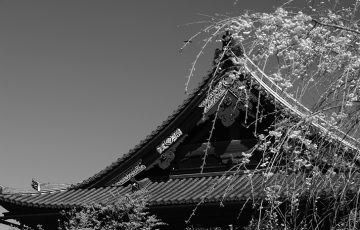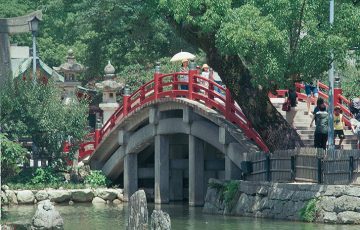 Among other claims to fame, the town of Kishiwada has the dubious honor of being the setting for director Miike Takashi’s ultra-violent, 1997 movie, Young Thugs, Innocent Blood, a harrowing account of growing up in a severely dysfunctional family. It’s difficult matching the scenes in the film with the tranquility of today’s town, though its proximity to Osaka and Kobe, home to the country’s highest concentration of Japanese Yakuza affiliated groups, makes its gangland narrative not entirely inconceivable.
Among other claims to fame, the town of Kishiwada has the dubious honor of being the setting for director Miike Takashi’s ultra-violent, 1997 movie, Young Thugs, Innocent Blood, a harrowing account of growing up in a severely dysfunctional family. It’s difficult matching the scenes in the film with the tranquility of today’s town, though its proximity to Osaka and Kobe, home to the country’s highest concentration of Japanese Yakuza affiliated groups, makes its gangland narrative not entirely inconceivable.
Kishiwada’s appeal though, is neither organized crime not social disfiguration, but history. Sections of this old castle town are very well preserved indeed. The older, core town in particular, an arrow’s distance from the castle moats, boasts some superb plaster-covered merchant houses and shops. There are lots of wood and copperplate covered buildings as well. Copper was used by the well-to-do, those who could afford to protect their buildings in hammered sheets of metal. The material has turned an algae-green over the decades, adding an appealing patina of age to the buildings. Copper is just as expensive today as it was to the merchants, who built these shop fronts in the Edo and Meiji period. Some of the better-off owners have replaced panels and copper finials with new sheets of copper that will remain bright and reflective during their early years.
Many of the older buildings that have been listed or designated as worthy of preservation, now serve as shops, ryokan, restaurants and exhibition spaces. Some of them retain the elegance of old machiya houses in Kyoto. While gentrification of this sort often equates with commercialization, it’s a far better option than abandoning or demolishing the buildings.
Many of these old buildings have held their ground. Unlike many other older quarters found in Japanese cities and towns, the old section of Kishiwada is far from being swallowed up by the hideous functionality of the new, though traditional buildings on the isolated fringes, not forming complete zones, streets or the sites of former estates and noble residencies, stand less chance perhaps, of surviving Japan’s insatiable developers. It may be true, as the late Edwin Seidensticker observed, that change in Japan is a tradition, but given the choice most of us would prefer to see some visible evidence of the past.
Kishiwada, at just 15km from Osaka, is hardly a world away, and yet the contrast with that bursting mercantile city could hardly be greater. But who are the visitors to Kishiwada? As castle towns go—and there are many with better natural settings and environs—this must surely rank as a minor destination. Perhaps that explains the singular appeal of the place for the small number of visitors who stumble in with low expectations, only to find an enclave of traditional crafts, shops and fine examples of period architecture.
 One event that does draw the crowds is its annual Danjiri Festival. This 300-year event is held every year on September 14th and 15th. Chrysanthemum shows are held in the same month. During the festival thousands of inhabitants run through the streets pulling wooden floats weighing up to 4 tons. The floats are designed to go move at precariously high speeds. Arguably, given that everyone likes a nice accident, the most exciting part of the festival is seeing the danjiri pulled at dangerously high speeds around narrow roads and street corners.
One event that does draw the crowds is its annual Danjiri Festival. This 300-year event is held every year on September 14th and 15th. Chrysanthemum shows are held in the same month. During the festival thousands of inhabitants run through the streets pulling wooden floats weighing up to 4 tons. The floats are designed to go move at precariously high speeds. Arguably, given that everyone likes a nice accident, the most exciting part of the festival is seeing the danjiri pulled at dangerously high speeds around narrow roads and street corners.
Occasionally floats tumble over or crash into a building or siding, all of which adds to the drama and spectacle of the race. YouTube even has a spot for the event, streaming images of accidents with floats crashing into the side of the road, participants holding on for dear life as they swerved out of control. Around 30 huge floats are used in the festival, each hand-made from zelkova wood. The wood is dried for two years before it is carved by woodworkers. The wheels are not so strong, and have to be changed several times during the two-day festival. Visitors can visit the Kishiwada Danjiri Hall and learn more about the history of the festival with audiovisual aids and exhibits
 The centerpiece of the town is unquestionably its castle. The original Kishiwada Castle was constructed in 1615, this developed some 25 years later with moats and stronger fortifications and services that evolved into a castle town. Like many castles built at this time, this one experienced no warfare, and after the Meiji Restoration of 1868, the castle’s owner donated the site to the city.
The centerpiece of the town is unquestionably its castle. The original Kishiwada Castle was constructed in 1615, this developed some 25 years later with moats and stronger fortifications and services that evolved into a castle town. Like many castles built at this time, this one experienced no warfare, and after the Meiji Restoration of 1868, the castle’s owner donated the site to the city.
One of the most remarkable features of the castle and its grounds is its highly original garden. Designed in 1953 by Mirei Shigemori, the leading figure in the development of the modern Japanese garden. Inspired by the military aspect of the castle, Shigemori’s stone settings are references to the eight-fold battle camp formation used by a Chinese general in an ancient mythological account. The stone setting at the center of the design, aptly called Central Camp, is the garden’s main stage. The view from the upper floors of the castle is not only superb, but helps to make sense of the strategic pattern of the garden.
Shigemori’s concern to reinvigorate the Japanese garden, resulted in highly original innovations like this garden. Shigemori’s favorite stone was ao-ishi, a kind of blue or greenish chlorite schist. Many of these highly assertive stones can be seen here. Shigeimori’s daughter performed in the staging of a traditional dance at the castle after the garden was formally opened, an unusual innovation at the time, but one entirely in keeping with his idea that gardens should have a multi-purpose function.
Ultimately, an appreciation of Shigemori’s work is a matter of personal taste, but the gardens are always alert, refreshing, “a compelling manifesto” as landscape designer Christian Tschumi has written, “for continuous cultural renewal.” Only time will tell whether works like this one will live up to his own criteria for permanence.
TRAVEL INFO
Most visitors go to Kishiwada from Osaka, which is just 15km south. Take the Nankai-tetsudo line from Sakai station. Most people do Kishiwada as a day trip, but if you would like to overnight, the Apa Hotel Kanku Kishiwada (077-433-7111) in the Miyamotocho area is handy and affordable. Kiraku (072-436-9955) in Minatomidori machi, is a Japanese restaurant with a nice range of tempura and soba lunch sets. Kishiwada’s big cultural event, much covered in the media, is its September Danjiri Festival. Anywhere between 500-1000 men push portable shrines on wheeled wooden carts of up to four tons through the streets in a performance that is both fast and dangerous. For more information on Shigemori’s work, see Christian Tschumi’s book “Mirei Shigemori: Modernizing the Japanese Garden,” published by Stone Bridge Press, and “Shigemori Mirei: Creator of Spiritual Spaces,” published by Kyoto Tsushinsha Press.
Story & photos by Stephen Mansfield
From J SELECT Magazine, June 2009















Recent Comments